Yes, really. If you love gemstones you'll want to know the difference.
May I ask why?
Exactly. "WHY."
If you've ever wondered WHY what you see in diamonds sparkle, it will become crystal clear below (see what I did there?). It's also fun knowledge if you enjoy nerdy conversations. So the next time you're partying with fellow diamond lovers, drop the information below, kick it around, and - best of all - share and compare all of your finger-blingers and earlobe-strobes.
BONUS: If you also want to define brightness, leakage, contrast and other performance components, check out the photos and info here: Diamond Performance Explained.
Spoiler alert: At the end of this page you'll learn how to take your diamonds on a brightness, fire and sparkle comparison test drive like a pro. Okay, I'm listening.Cool.
Imagine a room of chatty gemologists. When they talk about dispersion they're referring to a scientifically repeatable phenomenon. Diamond, as a material, reliably disperses light the same way, diamond after diamond after diamond. Every diamond on the planet has the same refractive index (it's 2.4175, by the way #nerdstuff).
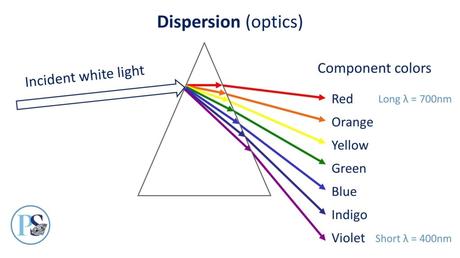
Now imagine a jeweler showing loose diamonds on a try. The word fire doesn't describe a constant. It describes a beauty component that's variable, diamond to diamond.
"Oy! This diamond has more fire than that one."That's because the human perception of fire is not constant, it's variable. And not just diamond to diamond: The same diamond presents with different fire in different environments. Depending on eyesight, acuity and age, the same diamond may even show different fire to different observers.
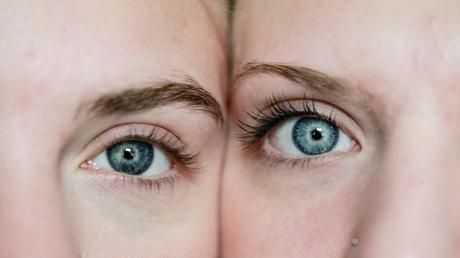 Say that shorter.
Say that shorter. Dispersion occurs physically, within the diamond.
Fire occurs physiologically, at the human eye.
Here comes the cool stuff. The word "FIRE" as as a diamond performance descriptor was developed by early diamond cutters, striving to maximize the reflections of fire from the gas lamps under which they worked. This is why diamonds cut in the 1800s were successful in producing big dispersive fans.
Disperso-what?Dispersive Fans: Diamond's high refractive index of 2.4175 (#nerdstuff again) promotes strong dispersion. When light travels through a diamond the different color-wave lengths begin traveling at different speeds and start to separate, or 'disperse' from each other, exiting in rainbows we call dispersive fans.
 How we see Diamond Fire
How we see Diamond Fire Here's your party trick: Fire is our human perception of dispersion.
Refracted light exits the diamond as a dispersive fan of rainbow colors. When that dispersed light reaches your eye there are two factors that dictate whether or not you perceive it as "diamond fire."
- The size of the dispersive-fan
- The dilation or constriction of your pupils at the time
When your pupil is dilated, or wide open, and rainbow bands of dispersion enter at once you don't see color. When your pupil is constricted, or small, and only one band of color enters you see THAT color. So a flash of color means only THAT color is entering your pupil.
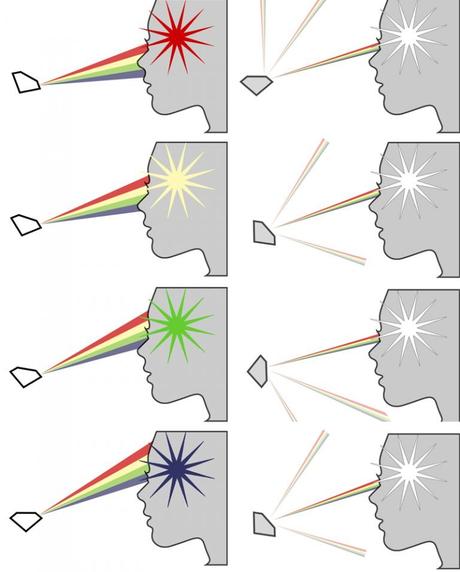 Whoa!
Whoa! Right! If a dispersive fan arrives to your eye and that bad boy is large enough that only RED enters your pupil, your brain sees a RED FLASH of diamond fire. If only the BLUE component enters you see a BLUE FLASH of diamond fire. How cool is that?

Dispersion can also be seen as white: When a dispersive fan is smaller than the size of your pupil and all component colors enter at once, your brain recombines them and sees a flash of white light (nerds don't count that as dispersion, we count it as brightness).
If the dispersive fan is tiny or weak you may not see anything.
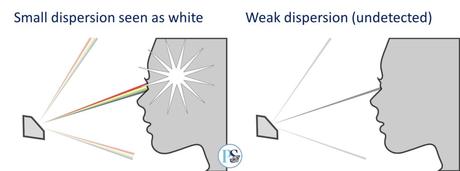 Action Shots
Action Shots Here is a montage I call "goodness SAKES on a plane."
These are photos of dispersive fans from my 0.76 carat super ideal diamond - aka my "guymond," according to my wife.
Sunlight entering the diamond is dispersed into its component colors and exits the diamond in dispersive fans which grow with distance. It's super cool and I encourage anyone with a window seat to try it. Oh, be prepared to tell everyone nearby where you bought your diamond because they'll want one too.
- At 30 cm away strong, separate colors are very distinct.
- At 20 cm away multiple fans can be seen, separated into their component colors.
- At 10 cm away dozens of small fans recombine against the aircraft wall, showing as white flashes.
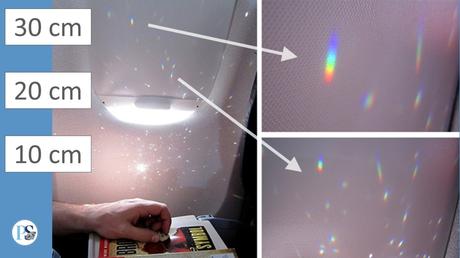
In scientific terms, this is called reverse-ray-tracing (#nerdstuff).
What you are seeing on the cabin of the airplane are fans of dispersed light. If the fan is wider than your pupil as it passes across your eye you "see" diamond fire. But of the fan enters your pupil all at once you see a flash of white light, as seen in this awesome photo provided by PriceScope member DiaGem.
The person above is seeing a flash of BLUE diamond fire. That's because only blue is entering the pupil. The red, yellow and green portions of the dispersive-fan appear on the iris. They are not entering the pupil, so they are currently unseen. If that dispersive-fan moves across the eye from left to right the blue-flash could become seen as blue fire, green fire, yellow fire and red fire, in sequence. BAM.
Diamonds. Are. So. Cool.
Brightness versus FireDiamond experts have known for a long time that high crowns and small tables (like antique diamonds) promote more visible fire because rays of light travel through more diamond material and disperse more. But this combination also produces less light return, therefore less brightness. While the reduction in brightness actually makes it easier to see small fire events that might otherwise be overwhelmed by white light return, the majority of people like a balance of brightness and fire.
Lighting Environments and FireA number of small bright light sources overhead will help you see fire in any diamond. You may also see it more readily in a low-lit environment like a restaurant with just a few lights or candles. Under conducive lighting, well-cut diamonds are capable of producing hundreds of different sized dispersive-fans simultaneously. Those which are wider than your pupil's diameter when arriving to your eye are seen as fire.
Dispersion occurs in all eight panels. Fire is only seen in four of them.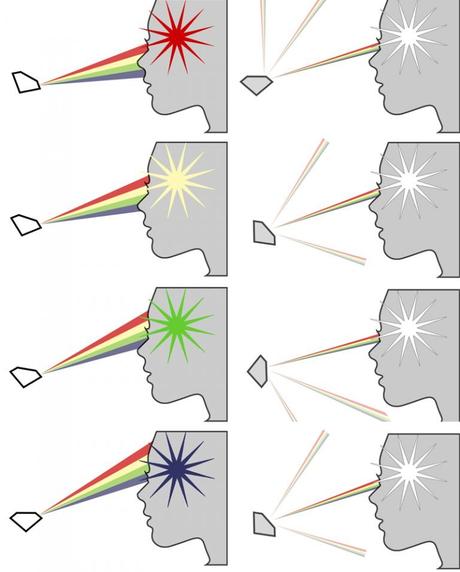
So dispersion is not fire. Dispersion creates the potential for a human brain to perceive fire. But whether you see fire in a diamond and how much you see, depends on how the diamond was cut, the panorama of illumination and your own physiology.
Written by John Pollard
Comments?Did you already know the difference? Do you have any dispersion photos to share? Will you start requesting window seats on planes? Was this article on fire? Let us know in the comments, or use the community link below to share with the entire PriceScope forum!
More ReadingLearn how to define brightness, leakage, contrast, and scintillation on our page Diamond Performance Explained.
Take your diamonds on a brightness, fire, and sparkle test drive: Make Comparisons Like an Expert.
Get fast answers to any question: Ask our community of unbiased independent helpers.Ready to find your diamond?
Written by John Pollard
